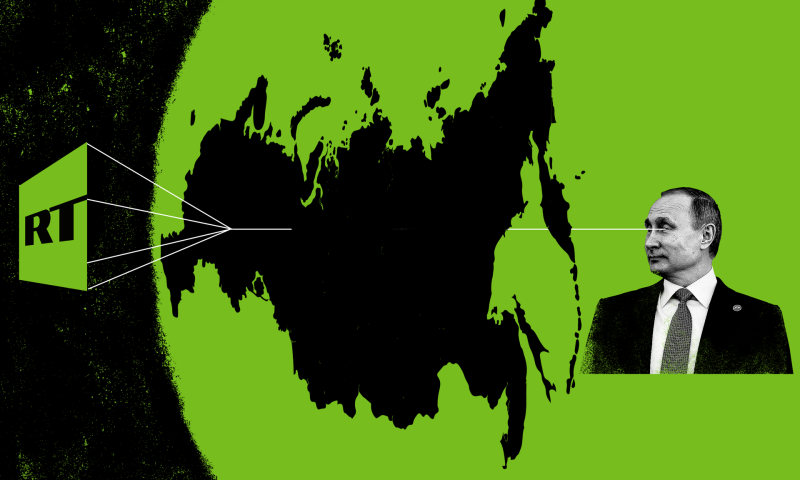
By Terrell Jermaine Starr, Foxtrot Alpha
Russia gets a lot of attention over its ongoing aggression in Ukraine and other former Soviet states. What does not get a lot of attention is Russia’s non-lethal methods of hybrid warfare to influence political outcomes in nations it considers adversarial. The tool for this at the Kremlin’s disposal is state-funded propaganda disguised as legitimate news—and it has the vast resources to distort the facts in ways that can potentially sway public perception to Russia’s favor.
In the U.S., “fake news” is an annoyance on your Facebook feed, or a charge lobbed at an outlet that reports something you may not agree with. In Russia, fake news is a weapon, and the guns that fire the bullets are its state news outlets like RT and Sputnik. RT doesn’t generate remotely the same ratings as CNN or other news networks, but they serve their geopolitical purpose: to create some degree of legitimacy among enough Americans who don’t believe in mainstream news.
This weekend, President Donald Trump accused former President Barack Obama of ordering a wiretap on Trump Tower during the presidential election. Even though a president cannot legally order a wiretap and Obama denied the accusation, RT ran an article Sunday leading with White House’s request to investigate whether Obama abused his powers in 2016.

The leading story for much of Sunday on Sputnik, the other arm of the Kremlin’s two-pronged English propaganda machine, focused on how the “Russian Dossier” story was the American media’s version of fake news. Neither outlet reported on how ridiculous these claims actually are, or the bipartisan concern that the White House is losing its kilter could be found on its pages this weekend. And there is no better time for RT than now, when the White House consistently accuses the major networks and print newsrooms of “spreading lies” about his administration.
Welcome to the information wars of the 21st century, a kind of warfare that is not new by any means but is being deployed in new ways.
And while many U.S. media outlets may run stories or narratives counter to the prevailing or “mainstream” ones, those outlets aren’t directly funded by the Russian government.
(Both Sputnik and RT did not reply to requests for comment.)
Foxtrot Alpha has reported on how France, Germany and the Netherlands have all accused Russia of trying to influence its upcoming national elections with fake news stories that favor nationalist politicians fond of the Kremlin. And America’s own intelligence community argued that RT waged a disinformation war to influence the election.
To be sure, research on how influential RT and Sputnik really are is limited for the moment, but it’s not hard to critique their coverage and ascertain how they are being used by the Russian state.
Throughout the year, Foxtrot Alpha will provide a weekly analysis of how Russian government-funded outlets like RT and Sputnik cover news here in the U.S. and how it contrasts to the American media narrative. We will also cover how other nations respond to fake news drives by Russia, and what that means for their national security. In the age of a commander-in-chief who has launched an unprecedented attack against the media and considers any non-positive coverage as “fake news,” we find it essential to track the reporting of RT and other English-language Russian state-sponsored news sources to understand how it is exploiting the current political climate.
The Kremlin’s News Network
Founded in 2005, RT began as Russia Today, a government-funded outlet meant to be a “soft-power tool to improve Russia’s image abroad, to counter the anti-Russian bias the Kremlin saw in the Western media,” according the Columbia Journalism Review. Primarily a cable channel, it has invested resources in its website and social platforms, particularly YouTube.
One may argue that the BBC gets state funding too, so what’s the difference? Well, for one, you don’t hear of BBC reporters publicly rage-quitting their jobs, as they have at RT on several occasions, because they could no longer “do work for [Russian President Vladimir] Putin” or spread “lies” for the Russian state.
As for Sputnik, it’s a radio network and website founded in 2014 to function similarly to the U.S.’ Voice of America. Again, the difference is in its aims. You generally don’t see any Watergate-level reporting from VOA, and it had a role countering communist propaganda abroad during the Cold War, it doesn’t overtly operate as a government shill like RT.
Rather than being a true news service, RT is a well-funded Kremlin PR arm with political aims that cannot be measured by Western methods of success such as TV ratings, ad dollar attractiveness, web traffic and other monetary incentives that U.S. media executives live and die by.
Instead, RT in particular exists as a conduit to spread the Kremlin counter-narrative against American media that depict Russian politics in less than a favorable light. Russia has been perfecting this form of media for a very long time. PropOrNot, an organization that tracks RT and Sputnik, told Foxtrot Alpha that there isn’t much research available that tracks their impact American audiences. The first mistake, though, is to rely solely on Nielsen ratings, which limit the appreciation of how powerful RT is.
“There are hundreds of thousands of YouTube views, bots, FB pages that do the same thing, though in subtle ways, a spokesman, who declined to give his name, said. “The thrust will be the same and use some text and act as repeaters for Russian media. To get a sense of effectiveness of the Russian bullshit firehouse, one must take into account all mechanisms through which their propaganda is delivered.”
Richard Tempest, a professor of Russian, East European and Eurasian Studies at the University of Illinois, told Foxtrot Alpha that the Kremlin has been practicing how to best create English language news for Western audiences since the beginning stages of the Soviet era. At first it was clunky and lacked the sophistication of its Western counterparts, but recently its approach has become more advanced and mirrors the formats of something like CNN or NBC.
Numbers Don’t Matter, Influence Does
To be sure, neither RT nor Sputnik score big ratings in America. The Daily Beast reported in 2015 that the television network often inflates its numbers and that, in 2012, it generated so few viewers that it didn’t register on the Nielsen ratings that year. The Washington Post this year noted that it is hard to gauge RT’s influence on American audiences.
While RT claims to reach hundreds of millions of people (including 10 million weekly viewers in the U.S.), Putin admitted during the network’s 10th year anniversary, in 2015, that they had no idea how many people watched the network. Here is what RT claimed last year:
Europe is the region where RT has the largest audience, with 36 million people watching the channel weekly. Eleven million get their news from RT at least once a week in the Middle East and Africa. In India, Ipsos included only English-language viewers, who constitute about 10 percent of the country’s population, and among them 7 million viewers watch RT weekly.
In the US, RT’s weekly audience is above 8 million viewers, the study showed, which places the broadcaster among the top-5 international TV news channels.
“Thirty-five million people watch us daily, and we are successfully competing with long-established channels worldwide,” said RT’s Editor-in-Chief Margarita Simonyan. “In 10 years we have truly succeeded in making our voice heard around the world.”
Tempest said the number he’s heard in the U.S. is around two million a week—still a paltry number by any measure—but even then it really doesn’t matter in the grand scheme of things.
“An American media executive would say, ‘Well, that’s not very impressive.’ But, from the Russian perspective, that’s two million (weekly) people who are exposed to a particular narrative, a spin on events that they’re interested in, be it Trump, Syria, the election before that, Ukraine,” Tempest said. “It’s a way to insert an official Russian perspective into the public conversation in the United States and to provide arguments to people who are sympathetic to Russian policy goals.”
On the web side of things, RT’s own website claimed 50 million unique visitors a month in February 2016. (To give you some context, the entire Gizmodo Media Group network of sites pulls in a combined 75 million unique visitors a month, per Quantcast.)
RT also has the advantage of timing. Given that many voters across the U.S. political spectrum have lost faith in the mainstream media, or do not trust what they perceive as negative coverage of the current administration, Tempest says the climate for an RT or Sputnik is better than ever.
“Somebody comes along and says, ‘Here is an alternative (view) on facts you don’t know about and explains things to you so they make sense,” said Tempest, who has studied and observed Russian media for more than two decades. “That’s very attractive.”
It’s also no great secret how badly the media missed the mark covering the last election. The coastal press corps failed to grasp the extent to which conservative voters and Trump supporters distrusted mainstream media, even when it engaged in nonpartisan fact-checking. Some audiences could find alternative viewpoints enticing—even if it is inaccurate. It’s this distrust that allows fake news, and RT, to proliferate.
How RT Spins
On March 1, RT ran a segment (you can watch the video below) called “Guilty By Association” that explored the media scrutiny Attorney General Jeff Sessions generated by not disclosing his meeting with the Russian Ambassador to the U.S. Sergey Kislyak.
Here in the U.S., the story wasn’t that Sessions met with Kislyak. It was not illegal for him to do so, especially as a member of the Senate Armed Services Committee. The problem was that, like Michael Flynn and other members of Trump’s administration, Sessions appeared to try to hide his contact with Russian officials while testifying under oath at his confirmation hearing, fueling already deep suspicions that the White House has some kind of financial relationship with the Kremlin.
“The idea is that you put out so much information that you confuse some percentage of the audience into believing things that aren’t true and, in doing so, you obfuscate the real story.”
But RT’s coverage instead questioned the journalistic ethics of American news outlets, arguing, essentially, that neither Sessions, Flynn or anyone else did nothing wrong by trying to strengthen ties with Moscow.
Of course, that was never the point and RT knows that. Like PropOrNot said, the blurring of the truth was very subtle. Not so blatant that we can call it a lie, but just light-handed enough to twist the narrative to sympathize with the Kremlin. After all, Russia does not want to look like the bad guy here, like it has somehow co-opted the new administration.
When you think of things in that context, much of RT’s coverage begins to make sense.
In a March 6 video satirizing the media’s drilling of Sessions (below), RT completely skipped over the fact that he gave a misleading answer to the question of whether he knew members of Trump’s campaign met with Russian officials or not.
If you’re Russia—and you operate this network to promote your aims—this report makes you look better. But then it’s no longer news; it’s counter-information warfare that doesn’t even try to sell itself as a serious news alternative.
The spokesperson said while most estimates of RT’s reach are around two million viewers per week, PropOrNot says its preliminary findings has that figure more around 15 million when you include social media. With more than 4.2 million followers on Facebook and close to 2.6 million on Twitter (which doesn’t include sub or topic-specific pages), RT can deploy a robust information offensive.
“The idea is that you put out so much information that you confuse some percentage of the audience into believing things that aren’t true and, in doing so, you obfuscate the real story,” said Dmitry Gorenburg, a senior research scientist at CNA, a nonprofit research and analysis organization.
RT at least seems to aim for a pretense of legitimacy by attracting top talent. Larry King, a journalist who came an institute at CNN for decades, has his own show on RT. Ed Schultz, a former MSNBC host, started working for RT in January of 2016. And, as BuzzFeed reported in 2014, journalists fresh out of college are paid between $50,000 and $60,000 to start at RT, which is often better than your average local newspaper or TV station will pay entry-level reporters.
It is not a cheap operation, but because it doesn’t depend on ad dollars, poor ratings will not determine its demise. Instead, it sits, conspicuously, in the American media ecosystem waiting to exploit any news angle it feels it can manipulate to Russia’s favor.
Here’s another example. On Monday former U.S. Director of National Intelligence James Clapper appeared on Meet The Press to push back against Trump’s assertion that Obama wiretapped him.
While Clapper admitted that no proof existed of Trump colluding with Russian leadership, RT muddled the exchange to suggest that Clapper wasn’t confident that Russia influenced the election.

Here is the subtle fudging of the truth. Chuck Todd asked Clapper, “There was a conclusion that said it’s clear the Russians interfered and did so in an attempt to help Donald Trump. Do you still believe that?”
Clapper: “Yes, I do.”
Todd: “But, at this point, what’s not proven is the idea of collusion?”
Clapper: “That is correct.”
Neither Clapper nor the report ever argued that Trump colluded with Russia, as RT suggested in its story. Clapper and the intelligence community did say they had evidence (which could not be declassified) that the Kremlin worked to manipulate public opinion. And no spy organization will reveal its complete findings of such a major operation that would risk the lives of its agents, assets and sensitive materials that could be traced if made public.
And the story ends on this:
At the end of February, the House Intelligence Committee chief, Rep. Devin Nunes, told journalists that they “still haven’t seen any evidence” of “any phone calls [between the Trump campaign and Russian officials]” but mysteriously added: “It doesn’t mean they don’t exist.”
Moscow has repeatedly denied allegations of contact with the Trump campaign, with the Kremlin spokesman lamenting that it’s become difficult to distinguish fact from fiction in the US media.
“Those reports are not based on concrete facts,” Dmitry Peskov said in mid-February, commenting on claims made by the New York Times and CNN, among others. Peskov noted that “there are five different sources in the story and none are named. So you see, really laughable stories are now given a go.”
The point of that article was not to fairly report on the complications of whether to declassify intelligence reports; it was designed to shake our faith in America’s top security institutions, and to help Russia wash its hands of this affair.
Watch video of the exchange yourself and compare it to RT’s report.
Much of the reason why RT has the potential to do damage in today’s media climate has to do with the changing of how Americans consume news. Katy Pearce, an assistant professor of communications at the University of Washington who studies media technologies in the former Soviet Union, said that social media has provided political entities like the Kremlin to manipulate news in ways that could not have been possible 15 years ago.
In 2017, social media algorithms direct news to the feeds consumers they prefer, giving them more power to share news items with their audiences regardless of whether it is completely accurate or not.
“Fifteen years ago, we had a much more simplistic media system and our news sources weren’t getting social endorsements,” Pearce said. “We generally trusted that the information that was coming to us through these mainstream sources were more or less verified. Sure, you could say there were voices that weren’t heard or that it wasn’t the entire side of a story, but nothing like the environment today.”
There’s the irony, though. That evolution of media—as in, cutting out the gatekeepers—isn’t necessarily a bad thing. A prime example of social media serving as good a public service came in August of 2014 when Michael Brown was shot and killed by a Ferguson, Missouri police officer. The photo of Brown’s body that circulated around the web spurred activists and independent media to jumpstart coverage on something the mainstream media struggled to document initially. And video streams of protests or other events from ordinary citizens on platforms like Facebook Live or Periscope can do what established news outlets can’t, or won’t.
As Pearce pointed out, the downside comes when entities that want to enter the ecosystem with news that’s not only inaccurate but intended to blur the truth become players and prey on the ill-informed—especially when they’re sponsored by a foreign government.
“It’s a great time to be be RT or any sort of entity that wants to introduce information with a particular bias or bent into our system,” Pearce said. “And it can do it very quickly, spread quickly, people are consuming it in different ways. Maybe it’s the golden age of fake news.”
By Terrell Jermaine Starr, Foxtrot Alpha





